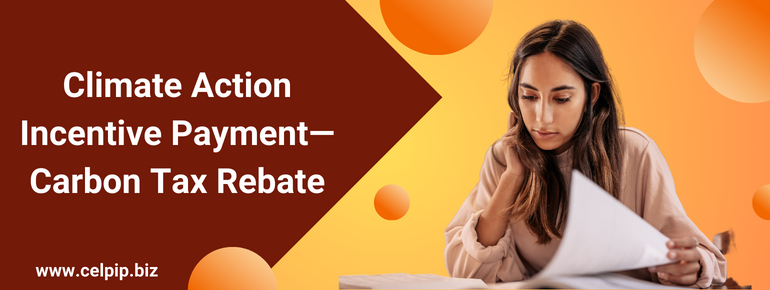Canada CAI: You got a check from the federal government that you didn’t expect. Do you know what it’s for? Furthermore, this could be because you’re used to receiving the climate action incentive payment (CAIP) but don’t understand how to use it. Find out about the scheme and how much money you can expect to get here.
Main Points
- The Climate Action Incentive Payment (CAIP) is a payment that qualified Canadians get every three months to help them pay for the costs of the carbon tax.
- If you live in Alberta, Saskatchewan, Manitoba, Ontario, New Brunswick, P.E.I., Nova Scotia, or Newfoundland and Labrador, you can get in on the CAIP.
- If you want to get Climate Action Incentive Payment (CAIP) funds without having to do anything, make sure you file your taxes on time every year.
What does the Climate Action Incentive Payment mean?
The Climate Action Incentive Payment (Canada Cai) is a tax-free amount that the government gives to people and families to help them pay for the pollution tax. People who live in Alberta, Saskatchewan, Manitoba, or Ontario can get it. It has a basic amount and an extra amount for people who live in small towns and rural areas.
The Canadian government has changed how the Canada Cai is paid for. Furthermore, instead of a refunded credit that can be claimed once a year on personal income tax returns, starting in July 2022, the government will make tax-free payments every three months through the benefit system.
However, the government fuel charge won’t start until July 1, 2023. It will only apply in Newfoundland and Labrador, Nova Scotia, and Prince Edward Island.
People who live in these states will get three payments every three months in the first year (July 2023, October 2023, and January 2024) and then four payments in the following years.
On July 1, 2023, the Canadian government will implement the federal backup fuel charge in New Brunswick. In October 2023, people in New Brunswick will get two payments, one for July and one for October. In January 2024, they will only get one payment.
Why does it exist?
The climate action incentive payment (CAIP) is money that the government gives to some Canadians to help them pay for the federal carbon tax.
Climate change is a problem for everyone in Canada, and we need to cut our carbon output a lot, and we need to do it quickly.
To help with this, the federal government started the federal fuel charge in 2019. Additionally, this is also known as the carbon tax, and it increases the price of things like gas for your car that releases carbon into the air.
Moreover, you and your family may have to pay more for some things because of this charge, but the good news is that you’ll probably get money back to make up for it.
The federal government isn’t keeping the carbon tax money: The Climate Action Incentive Payment takes the other 90% and puts it back into your and your friends’ pockets. They set aside the other 10% for small businesses and Indigenous groups. Most people will get back more than they pay; in fact, they will likely receive a net benefit.
Who benefits from the Canada CAIP?
The CAIP is a government program that helps places that don’t already have their own way of pricing carbon. However, there is a different system in place for people who live in Quebec or British Columbia, so they will not get the CAIP.
You don’t get the CAIP if you live in the Northwest Territories, Nunavut, or Yukon. Instead, you get a territorial refund.
That leaves eight provinces: Alberta, Manitoba, Ontario, and Saskatchewan have been part of the CAIP since the beginning and will remain a part of it (although in Alberta, the program is called the “carbon tax rebate”); and on July 1, 2023, the Maritime provinces joined the party.
The following things make you qualify for the CAIP:
- When it comes to income tax, you live in Canada.
- You live in one of the participating provinces.
- Furthermore, at least one of these things about you is true.
- Moreover, you must be at least 19 years old when we send the payment.
- There is or was a husband or common-law partner in your life.
- You have at least one child who lives with you or has lived with you.
In order for you to receive their full CAIP amount, there must be at least one child living with you, and you must list them under the Canada Child Benefit plan (CCB).
Additionally, you can still get half of the Climate Action Incentive Payment amount if your child doesn’t live with you full-time, even if you don’t have full care.
To get a payment, it takes these steps at the start of each payment month. There are four payouts a year. Say you turned 19 in August 2023. You would receive the payment for October 2023, but not the one for July 2023.
If you are married or live with someone, only one of you will receive the CAIP for your whole family. If you want to receive a payment for your child, you need to list them with the CCB.
How do I sign up for the CAIP?
Of course, the best thing about the Canada CAI is the cash. It’s also easy to start getting it. If you file your taxes every year, the payouts should come to you on their own.
Are you brand new to Canada? If you are new to Canada, fill out the following forms and follow the steps below to apply for the CAIP:
If you have kids:
- To apply for all child and family benefits, as well as the GST/HST refund, you must fill out and sign Form RC66, the Canada Child Benefits (CCB) application.
- Along with your Statement of Income, you must also fill out form RC66SCH, Status in Canada and Income Information for the Canada Child Benefits (CCB) application. This form asks for information about your status and residency in Canada.
If you don’t have kids:
- Form RC151, GST/HST Credit and Climate Action Incentive Payment Application for People Who Become Residents of Canada needs to be filled out and signed. Send the form to your tax centre by mail when it’s done.
If you reside in a small or rural town, you might be able to receive an extra payment called the “rural supplement.” Make sure to check the right box on page two of your income tax and benefit report to get this.
How much is the CAIP amount?
No matter how much money someone makes, they all get the same amount of Canada CAI. What you and your family receive will depend on where you live and how your family is structured. You will receive payments in April, July, October, and January.
The due dates for 2023 are April 14, July 14, October 13, and January 15, 2024. On all four of these dates, people who live in Alberta, Saskatchewan, Manitoba, or Ontario will get money.
In July 2023, people living in Newfoundland and Labrador, Nova Scotia, and Prince Edward Island started getting payments every three months.
People who live in New Brunswick will get a double payment in October 2023, and then payments every three months after that.
This chart from the Government of Canada shows that the amount of money an adult gets each quarter ranges from $92 in New Brunswick to $193 in Alberta, or up to $772 per year. The amount goes up based on the size of the family.
When will your money come in?
This is when you can expect to get your CAIP checks: on April 15, July 15, October 15, and January 15.
We will make the payment on the last business day before the 15th if the 15th falls on a Saturday, Sunday, or federal holiday.
You will also get your CAIP by direct payment if you get your tax refund that way. Visit our Direct payment page to learn more about it and find out how to sign up for it.
If your bank allows direct deposits, these payments will show up in your account as a “Climate Action Incentive” (the exact words may change depending on the bank).
It doesn’t matter if you owe money to the CRA or to other federal or provincial government programs. You will use the CAIP to pay off your tax bill.
You should wait 10 business days before calling the Canada Revenue Agency if you don’t get your CAIP on the due date.
Summary:
- Residents of specific provinces qualify.
- Quarterly Payments
- Offset carbon tax costs for Canadians.
- Payment Amounts Vary.
- Automatic for tax filers.
- We send CAIP directly to bank accounts.
- Tax Debt Settlement.
FAQs: Climate Action Incentive Payment (CAIP)
1. What is the Climate Action Incentive Payment (CAIP)?
CAIP is a tax-free payment provided to eligible Canadians to help offset the costs associated with the federal carbon tax.
2. Who is eligible for Canada CAI?
Residents of Alberta, Saskatchewan, Manitoba, Ontario, New Brunswick, P.E.I., Nova Scotia, or Newfoundland and Labrador are eligible for CAIP.
3. How do I receive CAIP funds?
If you file your taxes on time each year, we will automatically distribute CAIP payments to you.
4. What is the purpose of CAIP?
CAIP aims to encourage climate action by helping Canadians cope with the increased costs due to the federal carbon tax; thereby, it contributes to reducing carbon emissions.
5. How do we distribute CAIP payments?
Starting from July 2022, however, we make CAIP payments every three months through the benefit system, instead of individuals claiming them annually on income tax returns.
6. When does the government fuel charge apply?
The government fuel charge applies from July 1, 2023, but only in Newfoundland and Labrador, Nova Scotia, Prince Edward Island, and New Brunswick.
7. Who benefits the most from CAIP?
CAIP primarily supports provinces without their own carbon pricing systems. Residents of Quebec and British Columbia have their own systems and are not eligible for CAIP.
8. How much will I receive through Canada CAI?
The amount varies based on your province and family size. We make payments quarterly, and you can find the exact amount on the Government of Canada’s website.
9. When can I expect to receive Canada CAI payments?
We make payments on April 15, July 15, October 15, and January 15. If these dates fall on a weekend or federal holiday, nonetheless, we make payments on the last business day before.
10. Can I sign up for direct deposit for CAIP?
Yes, if your bank allows direct deposits, we will send CAIP payments this way. Visit the Direct payment page for more information.
11. Will you use CAIP to pay off tax debts?
Yes, you can use CAIP to pay off any outstanding tax bills, including those owed to the Canada Revenue Agency (CRA) or other government programs.
12. What should I do if I don’t receive my CAIP on time?
If you haven’t received your CAIP payment on the due date, however, wait for 10 business days before contacting the Canada Revenue Agency (CRA) for assistance.






